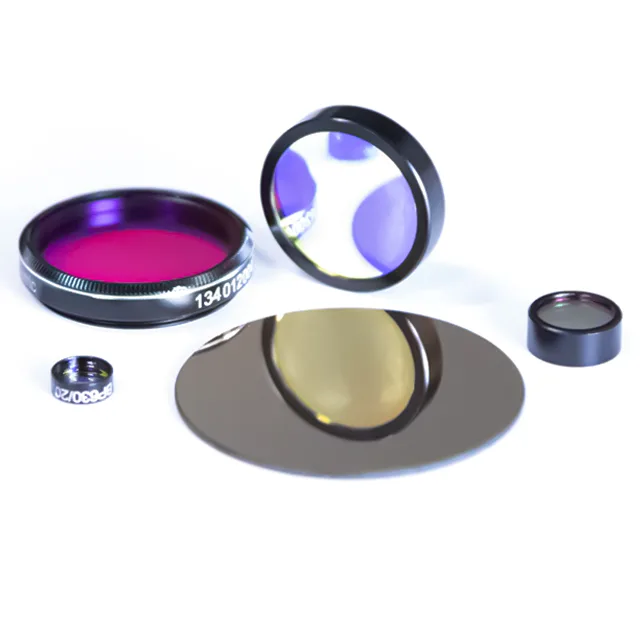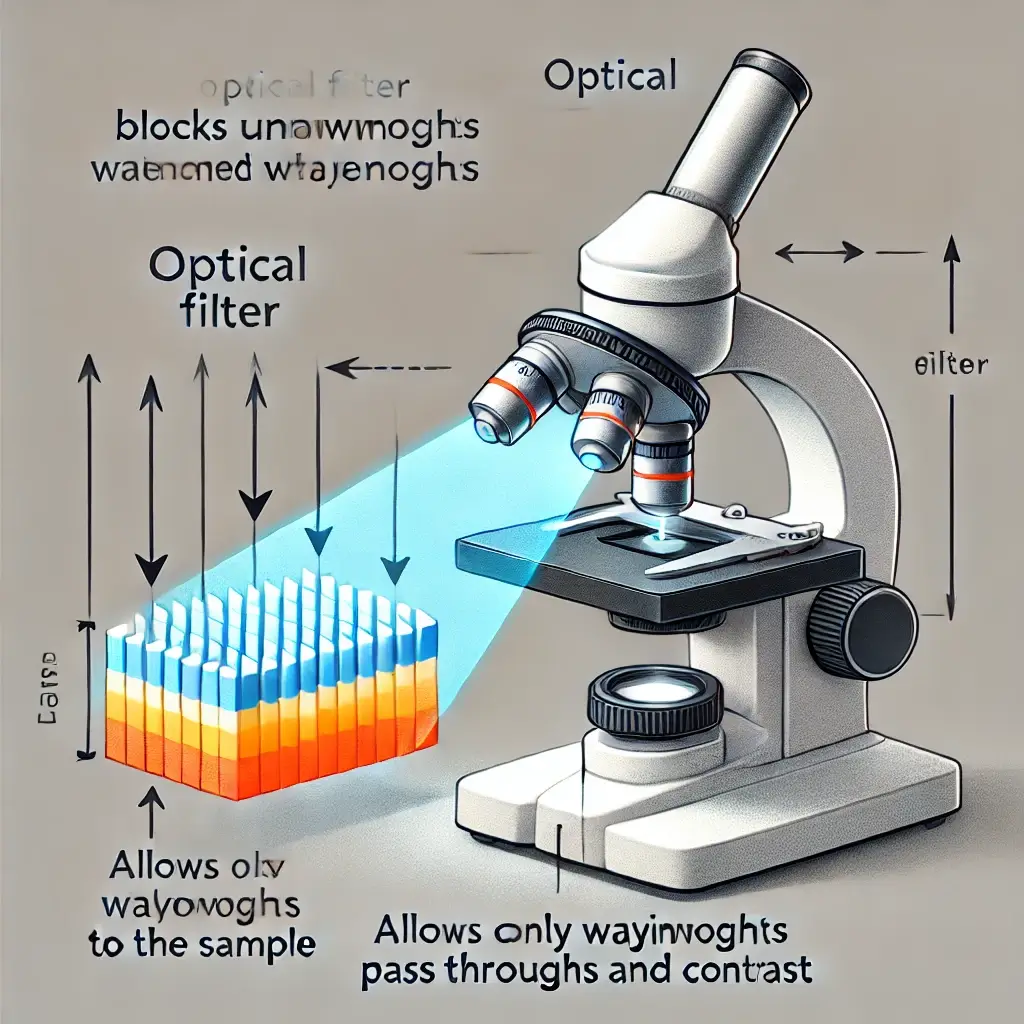Optical filters isolate specific wavelengths of light in microscopes for data collection and analysis. The variety and complexity of optical filters are dizzying, and this blog will learn about how to effectively select optical filters for microscopes and how they work.
What are Optical Filters?

An optical filter is a device used to pass or block light within a specific wavelength range selectively. These filters can absorb or reflect specific light and allow other light to pass, thereby changing the color or intensity of the light passing through it.
Optical filters are widely used in photography, scientific experiments, optical instruments, and glasses to improve the quality of images, protect vision, or enhance the performance of optical equipment.
Types of Optical Filters
Optical filters are generally divided into 2 types, including interference filters and cut-off filters. Cut-off filters are designed to block light of a specific wavelength range while allowing light of other wavelengths to pass through.
Optical interference filters, on the other hand, use light wave interference to selectively transmit or reflect certain wavelengths of light.
How Optical Filters Work
The working principle of optical filters is based on their materials and design, which determine which wavelengths of light are transmitted and which are absorbed or reflected.
This wavelength specificity is important in applications such as fluorescence microscopy, as it can isolate specific wavelengths of light, thereby improving the clarity of the image. High-quality filters, such as those provided by the Optolong brand, have excellent wavelength selectivity, ensuring optimal performance in scientific and industrial applications.
How to Choose Optical Filters for Microscopes
There are several key factors to consider when choosing the right optical filters. How to choose optical filters for microscopes depends on understanding the specific requirements of the application. Here are some steps in the selection process:
Wavelength Range
Determine the spectral range required for the experiment and select filters suitable for that wavelength range, such as UV filters for UV band experiments, visible light filters for visible light band observations, and infrared filters for infrared band detection.
Filter Type
Choose a cutoff filter or an interference filter depending on the specific application; cutoff filters block specific wavelengths of light, and interference filters are used to selectively transmit or reflect specific wavelengths with high precision, making them ideal for applications that require narrow bandwidth and high transmission efficiency.
Filter Quality
The quality of the filter affects the imaging effect of the microscope. High transmittance filters reduce light loss and provide brighter images. High-cutoff filters effectively block unwanted light and improve image contrast. Surface quality without scratches or stains ensures clear imaging.
Application Requirements
Different experiments require different filter combinations. For example, fluorescence microscopy usually requires excitation filters, emission filters, and dichroic mirrors, and phase contrast microscopy may require specific phase contrast filters.
Filter Size
Make sure the selected filter size is suitable for the microscope’s filter holder or filter wheel to ensure its correct installation and effective use.
Manufacturer and Brand
Choose reputable manufacturers and brands to ensure the quality and consistency of the filters and avoid affecting the experimental results due to filter quality problems. If you have any questions, you can consult Optolong’s sales team. We are committed to helping you answer your questions and help you make the best choice!
What do Optical Filters do in Microscopy?

Optical filters isolate specific wavelengths of light in microscopy. This isolation can improve the clarity and quality of the captured image. Microscopy applications such as fluorescence microscopy rely heavily on optical filters to distinguish between excitation and emission signals.
Enhance Image Clarity
Optical filters improve image clarity by blocking unwanted wavelengths. This process allows only the desired wavelengths to pass through. High-quality filters, such as those from Optolong, have excellent wavelength specificity. This specificity ensures that only the relevant light reaches the detector, resulting in sharper, more detailed images.
Separate Fluorescence Signals
Fluorescence microscopy requires precise separation of excitation and emission wavelengths. Optical filters achieve this separation efficiently.
For example, dichroic filters reflect excitation light while transmitting emission light. This separation minimizes background noise and improves the signal-to-noise ratio. Researchers can then obtain high-contrast images of fluorescent specimens.
Protect Samples and Equipment
Poor-quality filters can damage samples or sensors. High-quality optical filters protect samples and sensitive components of the microscope. Filters with a stable hard coating, such as those offered by Optolong, provide durability and long field life. This protection ensures reliable performance over time.
Customized for Specific Applications
Custom optical filters are tailored to specific requirements. Customization allows for unique shapes, sizes, and wavelength ranges.
This flexibility makes optical filters suitable for a wide range of applications, including professional research and industrial processes. Custom filters ensure precision and accuracy in demanding environments.
Conclusion
Choosing the right optical filters for microscopy can be effective in obtaining high-quality imaging results. Optical filters improve image clarity by isolating specific wavelengths of light. This isolation improves the signal-to-noise ratio and protects samples and equipment.
High-quality filters, such as those produced by Optolong, offer excellent performance and durability. These filters feature stable hard coatings, low autofluorescence, and high signal-to-noise ratios. Customization options allow tailored solutions to meet specific application needs.
In summary, there are several key factors that researchers and professionals should consider when selecting optical filters:
- Application requirements: Determine the type of microscope and specific wavelengths required.
- Filter specifications: Understand terms such as bandwidth, transmission, and blocking.
- Filter types: Depending on the precision needs, choose between absorption filters, interference filters, and dichroic filters.
- Filter quality: Choose high-quality filters with superior functionality.
- Customization: Explore customization options for unique shapes and sizes.
- Expert consultation: Seek professional advice to select the best filter.
Going through these considerations and considerations will help you make an informed decision.
FAQ
How can custom optical filters benefit specialized applications?
Custom optical filters are made to meet specific needs. Unique shapes, sizes, and wavelength ranges are possible. Customization ensures precision in demanding environments. Applications such as space missions and specialized research benefit from tailored solutions.
What role do optical filters play in protecting samples and equipment?
High-quality optical filters protect samples and microscope components. Filters with stable hard coatings provide durability. Low-quality filters can damage samples or sensors. Reliable filters ensure long-term performance and protection.
Where can I find high-quality optical filters?
Reputable companies offer high-quality optical filters. Optolong offers customizable filters with advanced coatings. Other companies such as Omega Optical LLC and Knight Optical offer precision filters. Researching these companies can help you find filters that fit your specific needs.
Related reading: What is The Optical Filter?
